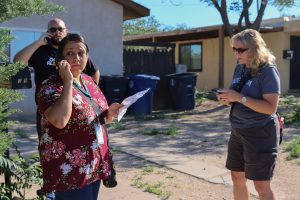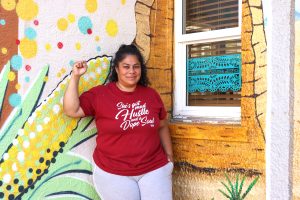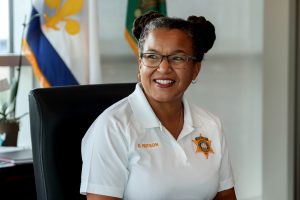- Slug: BC-CNS News21 Police Reforms Overview, 2,600 words.
- 8 photos and captions below.
By Sydney Gold and Layla Brown-Clark
News21
ALBUQUERQUE, N.M. – Deborah Vigil didn’t wear her gear one day in mid-July. As a responder for Albuquerque Community Safety, she’s allowed to work in plain clothes.
Sometimes her job is easier when it’s evident she isn’t a cop. Instead, Vigil wore a T-shirt that read “Dog Mom,” which fit naturally with the Snoopy hand sanitizer clipped to her bag and the paw-print lanyard around her neck.
Vigil and her partner, Chris Blystone, are both dog people, a passion they sometimes lean on at work.
“With the homeless population, sometimes the animals are all they have,” Blystone said. The partners can talk about their pets to build quick rapport with clients, who are often in crisis.
The pair work for Albuquerque Community Safety, a new department that Mayor Tim Keller refers to as a third branch of the city’s public safety response system. Its responders don’t arrest people. Instead, they offer access to such resources as mental health care, housing or a ride across town.
“The difference is, we’re not going to show up and take any of their rights away,” Blystone said.
Keller, who took office in 2017, has taken “bold action” to work toward lasting reform, according to the city’s website. In addition to the community safety department, Keller launched a crime initiative and created a new position: superintendent of police reform.
Some of the reform efforts in Albuquerque have taken years to come to fruition, with the 2020 murder of George Floyd by Minneapolis police serving as a catalyst to get things done – and get them done faster.
It’s a familiar story. Across the country, community organizers, nonprofit groups and elected officials have demanded police reform time and again, with spotty success.
“We’ve been here before,” said Howard Henderson, professor of justice administration at Texas Southern University and the founding director of the Center for Justice Research.
This time, however, Americans outside politics and activism are demanding police reform.
“We’re going through a paradigm shift,” Henderson said, “and you now have more people than ever before who are aware of the need for change. And so the difference now, unlike before, is that you now have a prevailing societal consensus that’s asking for change.”
In a Gallup online survey in May of more than 12,000 American adults, nearly 40% of respondents supported minor improvements to policing, and half favored major police reform – responses that have remained fairly consistent since nationwide protests against police abuses in 2020.
Despite such apparent public support, lasting, comprehensive police reform on a national scale hasn’t happened. The George Floyd Justice in Policing Act of 2021 never made it through the Senate. President Joe Biden’s eventual executive order addressing police reform lacked the sort of comprehensive overhaul Congress could have authorized.
At the state level, when police reforms do make it through legislatures, they’re often piecemeal, chipping away at a single policy or pattern of misconduct. And without state guidance, some individual police departments and cities across the country, such as Albuquerque, are taking their own steps toward police reform.
It’s what University of Minnesota law professor David Schultz calls “reform around the edges.”
“We’re missing the larger institutional issues about police departments, or missing the larger societal issues out there,” Schultz said. “A lot of the reform has missed this, and it really seems to be more microfocused right now.”
Those who study police reform agree that overhauling a centuries-old policing system with a history of brutality and corruption will require innovative and holistic solutions, along with support from the public, elected officials and those within law enforcement.
Others argue reform efforts aren’t enough, and the entire system should be abolished or defunded.
Still, experts and activists alike agree that lasting change will take time, and sometimes progress isn’t a straight line, especially when crime rises.
“The pendulum swings back and forth between equity, justice, fairness and social control, strict punishment, death penalty,” Henderson said. “The pendulum does this, and when it gets so far in one direction, it begins to work its way back in the other direction.”
That swing, he said, is a 20- to 25-year cycle.
Calls for reforms
In April 2021, a Brooklyn Center police officer pulled Daunte Wright over for a minor traffic stop. Shortly after, he was shot and killed. Since then, Daunte Wright’s mother Katie Wright has worked with city and community leaders in Minnesota to push for reforms, including a proposal to ban low-level traffic stops.
“We have a policing problem,” she said. “We have a white supremacy problem. We have a traffic stop problem.”
Wright said policing needs to change: “It’s not just a Black problem. It’s not just a white problem. It’s an ‘our’ problem, and we all need to stand up and make that change.”
Those changes come in many forms.
Campaign Zero, a high-profile national police reform campaign, lists 10 topic areas for policy solutions on its website. They include community oversight, limiting the use of force, independently investigating and prosecuting, community oversight and training.
The nonprofit’s efforts reflect many of the same focus areas coming from academics, activists and policymakers. News21’s “In Pursuit” project examined some of the most common calls for reform, including:
Transparency. Activists have demanded law enforcement open up their use-of-force reports, body-worn camera footage and misconduct data to improve accountability and build trust. The efforts have met with resistance overall. However, some states, cities and police departments have made efforts to open such records – with varying outcomes.
Response to mental health calls. Most strategies to deal with the law enforcement response to mental-health calls focus on shifting funds to social services, creating diversion programs or better training police officers. Experts say the solution relies on a combination of efforts: reduce or eliminate law enforcement’s role in behavioral health crisis response, train and equip law enforcement officers when they do need to respond, and improve treatment for psychiatric care.
Traffic stops. Government officials, community leaders and others across the U.S. are working to stop entrenched disparities in traffic stops, which are among the most common interactions the public have with police. Seven cities and Virginia have banned low-level traffic stops, such as for expired registration tags, broken taillights and other minor equipment violations, which reform advocates say too often are pretexts to search for drugs and weapons. Some cities are considering training unarmed civilians to conduct traffic stops while others are utilizing technology to address traffic violations.
Community review boards. The use of civilian oversight bodies has exploded nationwide. A Chicago study showed 25 major U.S. cities launched a civilian oversight agency in 2020 and 2021 – more than all five of the preceding years combined. But critics say the boards’ roles, power to discipline and impact on the community vary widely.
De-escalation. Standards for de-escalation – and even the definition of the term – are vague across police departments in the U.S., making reform efforts tentative. Still, as police encounters increasingly turn deadly in the U.S., supporters say de-escalation points toward an imperfect, but necessary way to reform.
Intervention. Departments are training officers to speak out when colleagues do something wrong or potentially illegal. Police and experts said they not only need training, but leadership and a change in culture to topple the blue wall of silence.
How change occurs
Joshua Reeves, the public outreach and performance manager at Albuquerque Community Safety, said the murder of George Floyd served as the major catalyst for action in his city.
“That moment across the country initiated an increase or a swell in political will,” he said.
“We sat down with local leaders and various experts throughout the city and said, ‘What should we do? How should this look?’”
After looking at other programs, the city launched Albuquerque Community Safety. The fiscal 2023 budget is $11.7 million for about 130 full-time positions.
The department has had early success, Reeves said, noting that 6,000 calls were diverted from police to Community Safety last fiscal year. Those are the kinds of calls that activists and politicians say often lead to unnecessary force and arrests.
But the change didn’t happen overnight, and Community Safety has faced backlash. One critic called the department’s creation “sloppy” and a publicity stunt by the mayor.
Sometimes mayors can push through police reform policy. Sometimes police chiefs do. And sometimes, legislators take the lead.
In 2021, Washington Gov. Jay Inslee signed a host of 2021 police reform laws, addressing such issues as use of force and no-knock warrants.
Several states have banned chokeholds, including California, Illinois, Nevada, Oregon and Virginia, according to the Los Angeles Times. As of February, 27 states had some kind of restriction on no-knock warrants, according to TIME.
But sometimes, departments aren’t given a choice about reform. When problematic departments catch the attention of the federal government, they’re often forced to take action.
For a decade, the New Orleans Police Department has been under a consent decree, a kind of legal agreement with the federal government that lays out a roadmap for reform. The Department of Justice launched its investigation into the department in 2010, prompted – in part – by officers’ behavior during Hurricane Katrina in 2005.
Lifting the consent decree has been discussed by the mayor, police department and the federal monitor, but the decree remains in effect indefinitely.
Additionally, New Orleans established the office of the Independent Police Monitor in 2009, an oversight office that monitors, reviews and audits police activity and data.
Albuquerque police also have an independent monitor who evaluates the department’s progress. The DOJ entered an agreement with the department in 2014 after federal investigators found officers had a pattern and practice of using excessive force, according to the Associated Press.
Ongoing challenges
In the office of SouthWest Organizing Project, a grassroots mutual aid organization in Albuquerque, Selinda Guerrero sits on a couch. Her red T-shirt says, “She’s got mad hustle and a dope soul.”
The grassroots organizer and activist said her community doesn’t call the police because it’s too dangerous: “Somebody might die or go to the plantation.”
“Our communities call John. They call me. They call Lo …”
“They call Tio Joe,” adds Loren Gomez, another member of the organization.
“We call Tio Joe,” Guerrero continues. “We go to the neighbor’s house. We call the homie down the block.”
Guerrero supports the abolition of all police, jails and prisons. For her and other activists, all reform efforts are insufficient because policing’s roots in slavery, anti-Black racism and colonialism make the system unreformable. They demand a complete overhaul.
Guerrero said the movement isn’t about the structure of policing.
“While we do want to dismantle and take away it, that’s not the focus,” she said. “It’s about what’s missing. That’s what abolition is actually about. Well-resourced communities, healthy communities make police obsolete.”
Although few police departments have disbanded entirely, the movement to abolish or even fully defund the police has become part of the cultural conversation.
Rising crime rates across the country also can hamper police reform efforts.
San Francisco voters in June recalled their reform-minded district attorney, Chesa Boudin, after a spike in crime. Police reform experts say this is a common pattern in the police reform movement – when crime rates rise, residents want tougher policies, not reforms.
There’s backlash at the state level as well.
Since cries of police reform roiled the U.S. in 2020, 16 state legislatures enacted laws tilted toward law enforcement. State lawmakers have reclassified law enforcement as a protected class under hate crime statutes, limited the filming of police officers and granted officers more rights during investigations into misconduct.
Such “Back the Blue” laws have been prevalent for decades but increased in the past two years.
Long-term movement
William Snowden describes violence as the expression of unmet needs.
“If we didn’t have police, that means people’s needs are being met,” said Snowden, the Louisiana director at Vera Institute of Justice, one of the country’s leading criminal justice reform organizations. Before joining Vera, he served as a public defender in New Orleans.
“We should be thinking about what an ideal kind of community or society looks like,” he said. “It means giving people the resources they need to thrive, to be safe and to be healthy and vibrant.”
The education, housing, and physical and mental health care systems all impact law enforcement. If these support systems don’t work well, there’s often only one tool left in the toolbox – police.
Before Stella Cziment joined the office of the New Orleans Independent Police Monitor, she worked for Recovery School District, a program intended to turn around the lowest-performing schools in Louisiana. In that work, Cziment saw exactly how policing can derail a young life.
“My goal was to keep young people out of disciplinary settings with the belief that these disciplinary settings could potentially put them in a pipeline to prison, the school to prison pipeline, which many people talk about and does exist,” Cziment said.
Blystone, with Albuquerque Community Safety, said his job becomes tougher when he doesn’t have the resources he needs – such as shelter space or hospital beds.
“There’s a thousand-piece puzzle, and we got about three pieces on the board,” he said.
Cziment bristles at calls to “defund the police” because that ignores the reality of America’s social safety net.
Police are in “a lot of spaces that they shouldn’t need to be, a lot of spaces that I would love to see other city agencies step into, other social services step into,” she said, but that requires other resources: job training, vocational training, educational services, child care vouchers and affordable housing.
Abolishing police wouldn’t force the government to build out these social safety nets, Cziment said, it would leave a gaping hole. And without police, people would hire private patrols.
“The problem with that is those individuals are not trained in de-escalation tactics,” she said. “They’re not trained on how to handle mental health crises. They’re not trained to be culturally sensitive to the differences in how you handle a child versus an adult. They’re not trained on any type of cultural approaches with certain types of individuals.”
And, she points out, private police are expensive.
“Whenever individuals want to talk about affluent communities that are able to not rely on the police, that’s not because they have such great services to fill in every other gap,” Cziment said. “It’s because they have a private patrol.”
Susan Hutson, Orleans Parish Sheriff and the first independent police monitor for New Orleans, said change happens in cycles. It happened during the civil rights era, and “we’re now full circle talking about it again.”
She agreed leaders must put more money into the systems that prevent crime.
“You have to be willing to fight for what you want,” she said. “And you’ve gotta be all in, and then you have to make sure that you get leaders in place who make that difference.”
Overhauling this system won’t happen overnight, in two years or two decades.
“The NAACP formed, and it took about 60 years to overturn Plessy,” Schultz said, referring to Plessy v. Ferguson, the Supreme Court’s landmark 1896 ruling that racial segregation did not violate the Constitution under a “separate but equal” doctrine. “It was a long haul, long game strategy. But they were always focused on the end game overturn.”
He said he believes activists, academics, politicians and community leaders need a similar, multi-generation approach to police reform.
“We need something like that now – a game plan that says this is the goal,” he said. “And it’s building a long-term movement to do that.”
News21 reporters Tirzah Christopher, Nathan Collins and Nina Howard contributed reporting to this article. This report is part of “In Pursuit,” an investigation into police reform and accountability in America, produced by the Carnegie-Knight News21 program. For more stories, visit inpursuit.news21.com.
^__=







